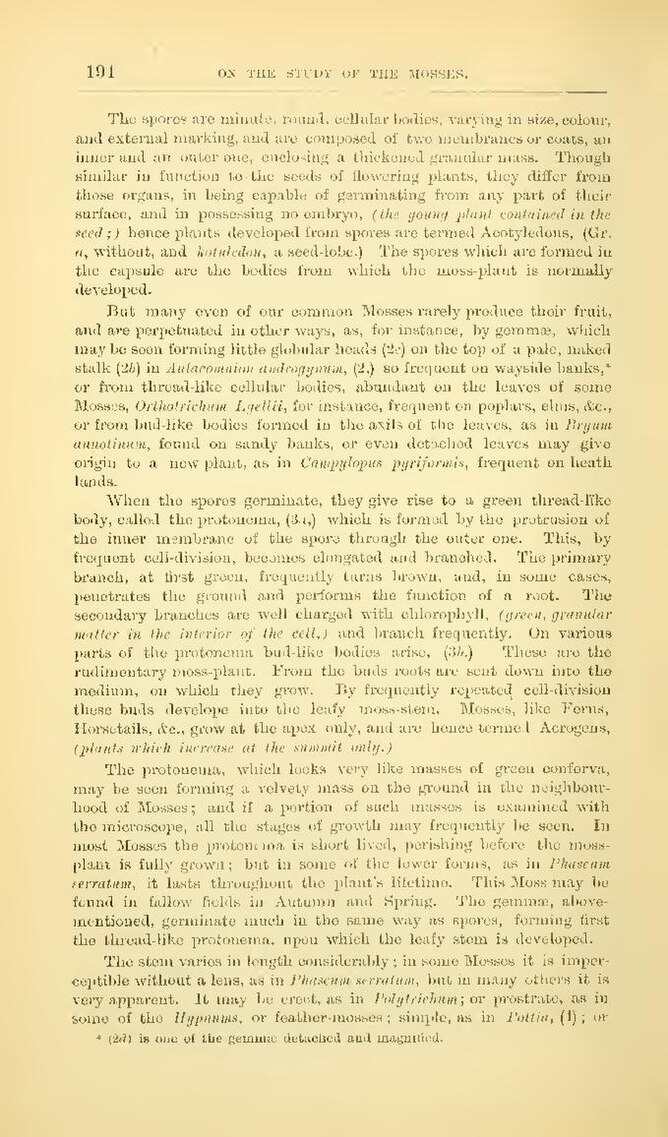The spores are minute, round, circular bodies, varying in size, colour, and external marking, and are composed of two membranes or coats, an inner and an outer one, enclosing a thickened granular mass. Though similar in function to the seeds of flowering plants, they differ from those organs, in being capable of germinating from any part of their surface, and in possessing no embryo, (the young plant contained in the seeds) hence plants developed from spores are termed Acotyledons, (Gr. a, without, and kotuledon, a seed-lobe.) The spores which are formed in the capsule are the bodies from which the moss-plant is normally developed.
But many even of our common Mosses rarely produce their fruit, and are perpetuated in other ways, as, for instance, by gemnmæ, which may be soon forming little globular heads (2c) on the top of a pale, naked stalk: (2b) in Aulacomnium androgynum, (2.) so frequent on wayside banks,[1] or from thread-like cellular bodies, abundant on the leaves of some Mosses, Orthotrichum Lyellii, for instance, frequent on poplars, elms, &c., or from bud-like bodies formed in the axils of the leaves, as in Bryum annotinum, found on sandy banks, or even detached leaves may give origin to a new plant, as in Campylopus pyriformis, frequent on heath lands.
When the spores germinate, they give rise to a green thread-like body, called the protonema, (3a,) which is formed by the protrusion of the inner membrane of the spore through: the outer one. This, by frequent cell-division, becomes elongated and branched. The primary branch, at first green, frequently turns brown, and, in some cases, penetrates the ground and performs the function of a root. The secondary branches are well charged with chlorophyll, (green, granular matter in the interior of the cell,) and branch frequently. On various parts of the protonema bud-like bodies arise, (3b.) These are the rudimentary moss-plant. From the buds roots are sent down into the medium, on which they grow. By frequently repeated cell-division these buds develop into the leafy moss-stem. Mosses, like Ferns, Horsetails, &c., grow at the apex only, and are hence termed Acrogens, (plants which increase at the summit only.)
The protonema, which looks very like masses of green conferva, may be seen forming a velvety mass on the ground in the neighbourhood of Mosses; and if a portion of such masses is examined with the microscope, all the stages of growth may frequently be seen. In most Mousses the protomoana is short lived, perishing before the moss-plant is fully grown; but in some of the lower forms, as in Phascum serratum, it lasts throughout the plant's lifetime. This Moss may be found in flow fields in Autumn and Spring. The gemmmæ, above-mentioned, germinate much in the same way as spores, forming first the thread-like protenema, upon which the leafy stem is developed.
The stem varies in length considerably; in some Mosses it is imperceptible without a lens, as in Phascum serratum, but in many others it is very apparent. It may be erect, as in Polytrichum; or prostrate, as some of the Hypaums, or feather-mosses; simple, as in Pottia, (1); or
- ↑ (2d) is one of the gemnmæ detached and magnified.
